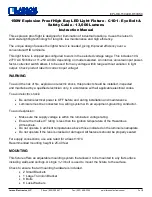
CRIRES User Manual
Doc. Number: ESO-254264
Doc. Version: P109.4
Issued on:
2021-12-01
Page:
73 of 99
Document Classification: ESO Internal Use [Confidential for Non-ESO Staff]
Nodding with polarimetry:
Nodding in polarimetric mode is more restrictive relative to the other modes. To avoid
crosstalk from the extended wings of the two simultaneously recorded orthogonal
polarisation states or contributions from the 0
th
order of unpolarised light, the polarised
beams are separated by 5’’ by a decker with 2.5’’ slits cut at the expected position of the
two beams (
Figure
43
). Since the locations of these slits are fixed, the allowable nod throw
SEQ.NODTHROW
is also fixed at a value of 2.5’’. No jitter can be applied for polarimetry.
For polarimetry, the total exposure time for one observing template with nodding
(
SEQ.NABCYCLES
≥ 1) is consequently:
DET1.NDIT
x
DET1.DIT
x
SEQ.NEXPO
x
SEQ.NABCYCLES
x
2
x
4,
whereas in staring mode (
SEQ.NABCYCLES
= 0):
DET1.NDIT
x
DET1.DIT
x
SEQ.NEXPO
x
4.
6.5 Offset conventions and definitions
CRIRES follows the standard astronomical offset conventions and definitions.
•
Position angles (PAs) are measured from 0 to 360 degrees. North corresponds to a
PA of 0 degrees, East, to a PA of 90 degrees.
•
All offsets are given in arc seconds.
•
Proper motions must be given in arcsec per year.
•
For solar system objects, additional tracking velocities are given in arcsec per
second.
•
For a position angle of 0 in SKY mode, the reconstructed SV image shows North up
and East left.
6.6 Attached night-time calibrations
Darks, flat fields and wavelength calibrations are taken during daytime as part of the
calibrations plan (see §7.1 for more details).
However, depending on the science goal, additional calibrations can be requested during
the night as well. For instance, dedicated templates for wavelength and flats calibrations
shall be attached immediately before or after the science template so that the gratings are
not moved in between. If the use of Molecfit or synthetic telluric spectra is not a valid option
for the correction of the telluric features, then users should supply a telluric standard star
OB. If the science requires accurate flux calibration, then the user must provide a spectro-
photometric standard star OB.
















































